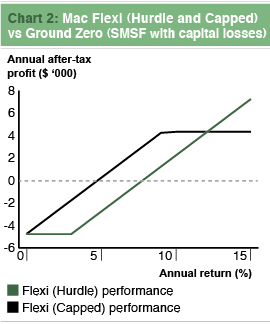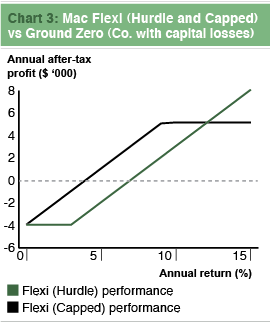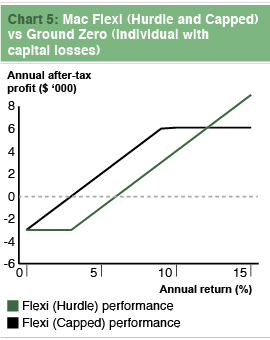Macquarie Flexi 100 Trust: Probably not
Key Points
- This a capital protected product financed with 100% limited recourse debt
- A similar proposition to Westpac Protected Equity Loan but some versions don’t require such extreme results
- May stack up for investors with the right appetite and attributes
The Product
When it comes to CPPs, Macquarie have all angles covered. Those with cash to invest can choose Macquarie Step and those without can go for its leveraged sibling, Macquarie Flexi.
The basic pitch is similar to Step—invest $100 and receive a capital guarantee at maturity plus performance linked to a reference asset. But there are a few key differences.
First, Flexi comes with compulsory leverage—a 100% limited recourse loan provided by Macquarie (who else?)—with interest payable at 7.95% a year, in advance. Flexi is also structured as a unit trust investment with income paid in the form of distributions. In that sense, it’s similar to a managed fund.
Second, Flexi offers a range of investment choices (check out page 2 of the current offer document) and a choice of a 3 ½ or 5 ½ year term. In this review, we’re going to focus on the two Australian Equity series—5 ½ year versions linked to the ASX200 price index.
If you’ve read Capital protected products: A dead end, you’ll know that the ASX 200 exposure doesn’t pay dividends. Macquarie is, however, kind enough to arrange a fixed 3% distribution on the trust units. Each year, you pay 7.95% in advance and receive 3% in arrears, with a variable distribution (based on ASX 200 performance) at maturity. The question is whether that changes the game.
The Proposition
Unlike with Step, with Flexi you don’t simply get paid according to the outright performance of the ASX 200. Instead, you have two options. The first (the ‘uncapped’ or ‘hurdle’ option) is to get ASX 200 performance in excess of 16.5% over the term (in other words, Macquarie deducts the 3% per annum it has already paid you). The second (the ‘no hurdle’ or ‘capped’ option) pays you performance from scratch, but caps your returns over the term at 50%.
With Step, we reiterated the point that CPPs don’t stack up on a pre-tax basis. With Flexi, the hurdle and cap don’t change that. Pre-tax investors—those who don’t value capital gains—can let this product pass through to the keeper. But what about those with capital losses or an attraction to the CGT discount?
Flexi introduces a couple of issues not present in Step:
- Flexi doesn’t pay performance as a capital gain. To turn your ASX 200 return into a capital gain you have to either exercise the walk-away option (refer section 3.6 of Part I of the PDS) or sell your units. Paragraph 6 of Flexi’s ATO product ruling states very clearly that the ruling ceases to apply in both cases. That doesn’t mean the treatment won’t work but it does introduce the risk of being challenged on it.
- Because Flexi investors don’t invest their own cash, there is a cost. This is paid for by the existence of the hurdle or cap. The financial benefit of these features to Macquarie probably approximates the benefit lost from not getting your cash.
Let’s now analyse Flexi on a pre-tax and after-tax basis. We have stuck with assuming the performance is received as a capital gain (despite our warning above) since there isn’t much after-tax benefit otherwise. In Westpac PEL: Explaining the play we made the point that these products don’t stack up on the year end prepaid interest deduction alone.
Because investors borrow to invest in the product rather than use their own resources, we won’t compare Flexi with a term deposit. Instead, our comparison is a zero return because there is no opportunity cost with Flexi.
Charts 1 shows the proposition for a 0% SMSF (or ‘pre-tax’ investor) under both the hurdle and capped versions. As you can see, the inclusion of the hurdle makes it very tough to avoid losing money and the cap means you don’t get a big pay-off if the bullish case works out.
To put it another way, the likely outcomes are all below zero and the unlikely outcomes aren’t far enough above it to make the exercise worthwhile.
Charts 2 to 5 replicate the scenarios from the Macquarie Step article. The best case is for the individual investor with truckloads of capital losses. You can see that, as the value of generating capital gains increases, the performance charts shift to the left. This has two crucial implications:
- The ‘break-even’ ASX 200 return reduces. For an individual with capital losses, it falls to about 3% for the capped version and 6% for the hurdle version.
-
The pay-off gets greater. A 9% return on the ASX 200 will deliver over $6,000 in after-tax profits to the investor in the capped version (even after deducting leverage costs).

So there’s a key decision. Do you choose the capped or hurdle version? For tax-conscious investors, the capped version is better. Pre-tax investors are better off with the hurdle (uncapped) version. That’s because the absence of a cap at least gives the chance of a big pay-off on a long-odds bet. But for an investor with capital losses we prefer improving the odds of winning the bet—the tax free nature of the pay-off means the upside is amplified anyway. This makes the capped (no hurdle) option a better choice.
The devil is in the detail
As with Step, Flexi has many of the same issues for consideration:
-
Credit risk. As Macquarie is funding you with a limited recourse loan, you have less credit risk than with Step. But the trust in which you invest (and your distributions) are exposed to the credit of the derivative counterparties.

- Liquidity. Flexi provides a quarterly ‘walk-away’ option which requires you to pay all relevant break costs and leave your fixed distribution behind. Like Step, it’s not a free option and doesn’t provide you with the liquidity of ETFs or shares. The investment may also be terminated early in limited (and unlikely) circumstances (refer section 4.1 of Part II of the PDS).
- Timing. As previously mentioned, CPPs don’t allow you to control the timing of either the entry or exit of the investment. Although you can exercise your quarterly ‘walk-away’ option, it comes at a cost.
- Product ruling. Flexi has been issued with an ATO product ruling (PR 2011/19) confirming its tax treatment, but note our warning that the ruling won’t apply if you exit early. We strongly urge you to seek professional tax advice if you are considering this product.
- Performance caps. The caps listed in this article are indicative only. Macquarie has the right to reduce the cap, or cap the uncapped version. It makes sense for investors to commit late and check the latest cap levels before doing so.
- Foreign exchange. Whilst we haven’t reviewed them specifically, if you are considering the USD-denominated Flexi series, keep in mind that your performance will be subject to foreign exchange risk.
- Averaging risk. If you are looking at the ‘Best of Basket’ option, please carefully examine the worked examples on page 6 of the PDS. As with Step, you don’t get capital protection on each element of the basket.
- Share performance caps. Finally, if you are considering the ‘Australian Equity Focus’ series note that the cap applies to the performance of each share rather than the overall portfolio.
Exotic options
Flexi offers a wide range of options beyond the ASX 200 variants; an Australian share portfolio, S&P 500 (US), Asian equity indices, an Asian long/short fund and an interesting ‘Best of Basket’ series.
The basic proposition remains, though. For Flexi to work out, you need to beat the net cash you are paying in interest each year (fixed distribution less interest in advance). For pre-tax investors, that will probably be a stretch. For those with a penchant for capital gains and the ability to get their head around the tax analysis, it has some potential.
An interesting aside is the inclusion of the Winton Global Alpha Fund in Flexi ‘Best of Basket’. Those who have been fans of the Man series of products (whether or not you are interested in Flexi) should take a look at the Winton strategy. Winton founder David Harding was also involved in the development of Man’s flagship AHL Diversified trading program. The Winton strategy has outperformed the Man strategy—with lower costs—in recent years.
In a nutshell
Flexi is another CPP that doesn’t stack up for pre-tax investors. As with Westpac PEL, the hurdle versions of the product require extremely favourable results for investors to win out. As for the capped versions, they’re worth considering if you are a sophisticated or adventurous investor. But, if you’ve got the cash, Step is a better option.











